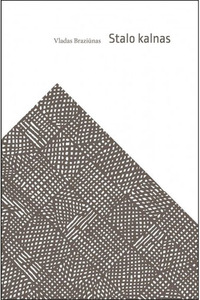Linguistic restoration of being 1
In brief: The world we see in V. Braziūnas "Table Mountain" (Stalo kalnas, 2014, Vilnius: Lithuanian Writers' Association publishing house) is the place where male and female were based on different types of understanding, when the world and being where sacred and a human was able to meet another human without any cultural differences and in agreement view the images with the eyes of the soul.
"Table Mountain" - is a polysemous and many-sided image, which was made meaningful visually by the book designer Sigutė Chlebinskaitė. The book cover is created with sensitivity in the style of minimalism. We see a fragment of Algirdas Steponavičius drawing (1965) and its black and white tetragon triangle seems like a table and if we look vertically - a mountain. The idea continues into the flyleaf of the book.
Visual language continues verbally - the meanings of Table Mountain are explained and spread through texts, starting with literary contexts. Firstly with the excerpt from Vladimir Nabokov's semi-autobiographical novel Look at the harlequins (2012), "The great pleasure, pleasure parapet, will allow me to finish the job perfectly: then, a clear and compact altar, like something great and strong appeared on my mind! Table Mountain! <...>. My trusting hands were still spread apart but I did not feel the soft soil with my feet. I longed to get back to you, to life." A task - a mission performed while going into you - the supreme creator, who is in life, the life itself. One refuses and loses him/herself, in order to become him, in him - all in one. Table is a matter, a kind of literary workshop, accommodating writer's everyday life and being. It is a foundation on which stands the mountain - a world, which unfolds with words.
V. Braziūnas certifies the human. He makes his being meaningful with body as nature and unity of all the elements of being, "Silent, enchanting music, lips / poppies, the mysticism of lives of the saints / a joint of the stone / find in my old body / a dimmed eye, seeing / a fire smoldering the abyss / <...> you will have me, only me / not here, secretly, in the water, underground / by ripping off a woolen shirt of baptism" (p. 94). The old body that has been described, drawn, thus after the death, when a material body - the shirt of baptism - will have been worn out and taken off, a human will have lived everywhere and in everything and will have become the life of the world itself. Even though poet uses other cultures, he still is a Balt in a Christian contexts.









